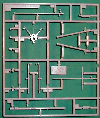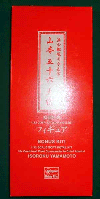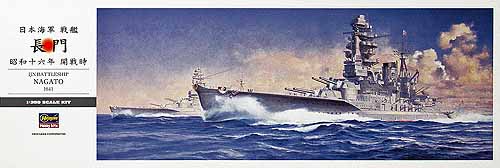| HISTORY |
|
|
Nagato and her sister ship Mutsu were this first battleships to have 16" guns as
the main battery. Nagato, completed before her sister in 1920, was one of the most formidable
capital ships in the world at that time.
Nagato underwent an extensive rebuild in 1936, including a re-boilering - converting from twin funnels to a single -
large changes in the bridgeworks and superstructure, and the addition of a large torpedo bulge.
Nagato served throught World War Two, taking part in the battles of Pearl Harbor, Midway and Leyte Gulf. She was the single
IJN capital ship to survive the war, and was later "expended" at the second Crossroads nuclear test in July, 1946.
This is the first 1/350 plastic Nagato ever available, and Hasegawa has released her in
a 1941 configuration. It looks to be the first in a new series
of World War Two Imperial Japanese Captiol Ships to be released from Japanese model manufacturers.
|
|
|
|
|
| HULL PARTS |
|
|
This two-part hull is offered in a full-hull variant only. Those wanting a waterline version
will need to break out their hobby saws or Dremels.
The hull has plenty of detail; the portholes (scuttles) are recessed, and each features a fine brow.
Numerous hull opening are indicated throughout, and a degaussing cable runs the length of the hull.
The casemate gun deck is part of the hull, with four
angled openings per side. The bilge keels are molded on, and are a bit thick and out of scale. There is an
interesting gap built into the bottom between the torpedo bulge and the original hull.
One of the interesting things about this is kit is the bulkhead system. It is one of the unique
things about this model, and I wonder if we will see more of this in the future. The bulkheads
should not only prevent the hull from shifting out of shape, but also provide a very stable set of
supports for the deck pieces. The system of 13 bulkheads
run the length of the hull, with provisions made for the rudders to attach to frame 12, and separate
pieces for the extreme bow- where the anchor hawse holes are. Did Mutsu have a different anchor
arrangement?
Much as been made of the hull plating lines on this kit. Whereas the lines on the hull itself
are mostly offset like one would expect to find, the lines on the bulged and up-armored sections is in
straight vertical and horizontal lines. Whether or not this pattern in correct, I don't know. I don't think
it looks right. However, I am fairly certain that these lines should be raised weld lines, not recessed
like panel lines on an aircraft. Seems to me a rather monumental screw-up on Hasegawa's part.
|
Click images
to enlarge |
 |
|
|
| SPRUES B&C |
|
|
Sprues B&C are attached, and hold the forward deck area, the bow pieces and the hull part
that has the rudder openings attached. Also on this sprue are the angled shaft supports. The
deck has basic planking lines, but no individual planks are indicated. Various deck details, hatches
bollards, etc, are molded in place. The capstans are separate pieces to be added later. There is no molded-on anchor
chain; metal chain is provided in the kit to represent the anchor chains.
The underside of the deck shows many mounting holes not used on this version. I would gather a late-war
Nagato or Mutsu is in the future.
|
 |
|
|
| SPRUE F |
|
|
The rest of the deck pieces are on Sprue F; the stern plate and an amidships one. The simplified
plating is continued on these parts, as well as extra, unused mounting holes beneath the deck.
Another curious thing are the vertical "spring" posts for mounting the 01 deck. I'm not sure what the
exact function of these are, and will be curious to hear from builders how this effect construction.
The shaft skegs round out this sprue. I like the system of pegs to fit into the supports to aid shaft alignment,
but I still prefer brass rod for my shafts.
|
 |
|
|
| SPRUE G |
|
|
Sprue G has the bulkheads for the hull. Bulkhead 12 fits with a part from "C" to fill an opening
in the hull, and provides a socket for the rudders to attach; the rudders are implaced with polycaps,
allowing them to be moveable.
|
 |
|
|
| SPRUE J |
|
|
Sprues J, K, and L all deal with the extensive main bridge assembly, bridge deck and flight deck. These parts
are extensively detailed, and build up layer-by-layer; as one would expect. There are many places
where parts must be shaved off, or holes drilled- more evidence there are other ships planned.
|
 |
|
|
| SPRUE K |
|
|
Main Bridge Part 2
|
 |
|
|
| SPRUE L |
|
|
Main Bridge Part 3.
|
 |
|
|
| SPRUE M |
|
|
Mainmast parts comprise most of this one, plus the crane boom. Be careful cleaning up after the little sprue stubs- some of those
parts are fragile. I found the sprue structure around the mainmast "star", there to protect it against casual
contact, and interesting feature.
|
 |
|
|
| SPRUE N x4 |
|
|
The N Sprue; the main battery sprue. Nagato's 16"/45 rifles are the main attraction here.
The turret bottom has some detail in the rear- this is the first time I've ever noticed
detail on the bottom of a turret, other than the odd angled support.
The main barrels are molded in a solid, single piece fashion, and fit into premolded blast bag parts.
Each barrel has a short bore opening, and straps to indicate how the blast bags are held down.
They have a small mold line, and should clean up easily.
5 of the ship's
18 5.5"/50 secondaries are on each sprue, giving the modeler 2 spare. I like the little combo shield/breech for
each gun.
The ubiquitous polycaps are in the same bag as this sprue. They are used not only in the
placement of the main guns, but also allow the main range finder to rotate. Also, the pointed tips of the
ship's screws are on here.
|
 |
|
|
| SPRUE Q x2 |
|
|
Here we have various parts; the largest of the hull bulkheads,
as well as internal round frame-like supports for the bridge
deck assembly
. The legs for the famous heptapodal mast in the main bridge
structure are also on this sprue. with the ship's screws, rudders and many of the ladders.
Hasegawa has included many steps using either the round frame support/spreaders, or bulkheads;
it's an interesting solution to keeping the superstructure parts (and hull) from buckling.
|
 |
|
|
| SPRUE R |
|
|
Sprue R is what the directions call the "rear bridge assembly." Some of the detail
on the structure pieces continues to be soft. More of the little sprue stubs on the platform parts.
|
 |
|
|
| SPRUE S |
|
|
The funnel and lower funnel structure make up most of this one. Lots of great detail,
steamlines and the like. The solid lattice-like pieces make up the searchlight platform.
Could probably use a PE replacement, but rebuilding that area could prove troublesome.
|
 |
|
|
| SPRUE T |
|
|
The clear parts sprue, with bridge windows, searchlights and more! Clear windows for the
battery rangefinder
s!
|
 |
|
|
| SPRUE AE x2 |
|
|
This sprue consists of the ship's boats and most of the davits.
|
 |
|
|
| SPRUE AF x4 |
|
|
One of the interesting things about this sprue is its label- it is not specific to "1/350 Nagato class
battleship" like many of the other in this kit, it is lableled simply "1/350 Gun." I wonder what
other IJN battleships or cruisers Hasegawa may have planned?
As the "GUN" sprue, it is festooned with AA guns and mounts. There are also a large number
of ready ammo boxes present, in addition to paravanes, AA directors and binoculars, as well as
many various deck details.
Most of the guns are satisfactory; the triple 25mm's on the sprue are not as detailed
as the recent Tamiya offering, but are a marked improvement of Aoshima's recent attempts.
|
 |
|
|
| SPRUE AC & AD |
|
|
These two sprues build up into the aircraft catapult and the aircraft launch and handling cradles.
|
 |
|
|
| AIRCRAFT |
|
|
3 Nakajima E8N "DAVE" spotter planes are included. There is no provision for displaying the planes
with the wings folded.
|
 |
|
|
| BONUS FIGURE |
|
|
Also included in this kit is a limited edition 1/32 "Soft Metal Kit" of IJN
Combined Fleet Commander-in-Chief Admiral Isoroku Yamamoto.
|
 |
|
|
| DISPLAY BASE OPTIONS |
|
| Two pedestal bases are included for full hull display. |

 |
|
|
| DECALS AND DETAILS |
|
|
There are two sheets included; a standard water-slide decal sheet with all the appropriate markings
for the hull, spotter planes and base. And additional sheet of signal and battle flags, with different
admiral's pennants is included. This second sheet comes as a sheet of adhesive stickers, instead of plain
paper or waterslide decals.
A length of metal anchor chain is included.
|
|
|
| COLOR CHART AND INFO |
|
|
A poster with painting references is inlcuded, in full 1/350 scale. Colors are in the
standard Gunze line. The reverse of the poster is a full 1/350 rigging plan, with a few PE references
thrown in. There is also a photo booklet included. Unfortunately, the text is in Japanese, the images inside
should prove helpful during the build. |
|
|
| INSTRUCTIONS |
|
|
A twenty-four page instruction booklet describe the assembly in great detail
with a variety of sub assembly views. These instructions are well done
and should provide all the information that is needed to build this ship.
There is a correction sheet included, which updates page 17 and adds additional painting detail.
|
|
|
| CONCLUSIONS |
|
An impressive offering from Hasegawa, thought the kit has its issues. This kit is, I believe, the first plastic battleship to cross the $200.00USD barrier,
having a suggested retail price $214.95.
Many thanks to Modelwarshipper Kym Knight, who arranged for us to see his kit and goodies while on a detour from its route
to Australia. Thanks Mate!
|


